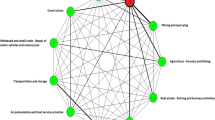Abstract
Weather forecasting is an important issue in the field of meteorology all over the world. The pattern and amount of rainfall are the essential factors that affect agricultural systems. India experiences the precious Southwest monsoon season for four months from June to September. The present paper describes an empirical study for modeling and forecasting the time series of Southwest monsoon rainfall patterns in the North–East India. The Box-Jenkins Seasonal Autoregressive Integrated Moving Average (SARIMA) methodology has been adopted for model identification, diagnostic checking and forecasting for this region. The study has shown that the SARIMA (0, 1, 1) (1, 0, 1)4 model is appropriate for analyzing and forecasting the future rainfall patterns. The Analysis of Means (ANOM) is a useful alternative to the analysis of variance (ANOVA) for comparing the group of treatments to study the variations and critical comparisons of rainfall patterns in different months of the season.








Similar content being viewed by others
References
Brocklebank JC, Dickey DA (2003) SAS system for forecasting time series, 2nd edn. SAS Institute Inc, Cary
Chang X, Gao M, Wang Y, Hou X (2012) Seasonal autoregressive integrated moving average model for precipitation time series. J Math Stat 8(4):500–505
Chartfield C (1980) Inverse Autocorrelations. J R Stat Soc A142:363–377
Chonge Metrine, Nyongesa Kennedy, Mulati Omukoba, Makokha Lucy, Tireito Frankline (2015) A time series model of rainfall pattern of Uasin Gishu County. IOSR J Math 11(5):77–84
Cryer JD, Chan KS (2008) Time series analysis with application in R, 2nd edn. Springer, New York, p 491. ISBN 0387759581
Dobler A, Ahrens B (2008) Precipitation modelling in Europe and South Asia. Meteorol Z 17:499–509
Ebell K, Bachner S, Kapala A, Simmer C (2008) Sensitivity of summer precipitation simulated by the CLM with respect to initial and boundary conditions. Meteorol Z 17:421–431
Eni D, Adeyeye FJ (2015) Seasonal ARIMA modeling and forecasting of rainfall in Warri Town, Nigeria. J Geosci Environ Prot 3:91–98. doi:10.4236/gep.2015.36015
Guo ZW (2009) the adjustment method and research progress based on the ARIMA model. Chin J Hosp Stat 161:65–69
He SY (2004) Applied time series analysis, 1st edn. Peking University Press, Beijing
Kantz H, Schreiber T (2004) Nonlinear time series analysis, 2nd edn. Cambridge University Press, Cambridge, p 369. ISBN 0521529026
Men B, Xiejing Z, Liang L (2004) Chaotic analysis on monthly precipitation on hills region in Middle Sichuan of China. Nature Sci 2:45–51
Momani M, Naill PE (2009) Time series analysis model for rainfall data in Jordan: case study for using time series analysis. Am J Environ Sci 5:599–604. doi:10.3844/ajessp.2009.599.604
Stoffer DS, Dhumway RH (2010) Time series analysis and its application, 3rd edn. Springer, New York, p 596. ISBN 1441978658
Wang J, Du YH, Zhang XT (2008) Theory and application with seasonal time series, 1st edn. Nankai University Press, Chinese
Wang HR, Wang C, Lin X, Kang J (2014) An improved ARIMA model for precipitation simulations, Nonlin. Processes Geophys 21:1159–1168
Weesakul U, Lowanichchai S (2005) Rainfall forecast for agricultural water allocation planning in Thailand Thammasat International. J Sci Technol 10(3):18–27
Zaw WT, Naing TT (2008) Empirical statistical modeling of rainfall prediction over Myanmar. World Acad Sci Eng Technol 46:565–568
Zhou ZJ, Hu CH (2008) An effective hybrid approach based on grey and ARMA for forecasting gyrodrifts. Chaos Solitons Fractals 35(3):525–529
Author information
Authors and Affiliations
Corresponding author
Additional information
Responsible Editor: M. Kaplan.
Rights and permissions
About this article
Cite this article
Narasimha Murthy, K.V., Saravana, R. & Vijaya Kumar, K. Modeling and forecasting rainfall patterns of southwest monsoons in North–East India as a SARIMA process. Meteorol Atmos Phys 130, 99–106 (2018). https://doi.org/10.1007/s00703-017-0504-2
Received:
Accepted:
Published:
Issue Date:
DOI: https://doi.org/10.1007/s00703-017-0504-2




